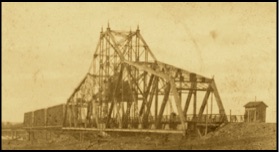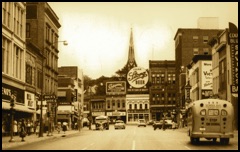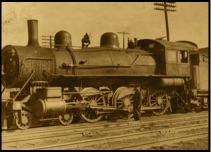Historical Society of
Pottawattamie County
County Seat Council Bluffs, Iowa



The Historical Society was organized November 26, 1907.
Though there’s a temptation to think of Council Bluffs in 1907 as being a fairly new town, many residents were concerned at the time its history was slipping away and something needed to be done. Some of the pioneer settlers were still around but getting on in years; the opportunity remained to document first hand accounts of Pottawattamie County’s earliest times but it was fading fast. Additionally, artifacts relevant to local history were in the drawers and cabinets of homes across the city, and likely to be lost over time. The new group planned to bring this memorabilia to a central location for all to enjoy and take responsibility of protecting and preserving it. Former Mayor Millard Rohrer suggested a portion of the library be made a museum. While noting while this would require an extra employee to care for it he felt sure the library board of trustees would willing provide for such an expense. Educational programs were considered a priority, and though the impetus to form was coming from Council Bluffs it was felt the entire county should be involved.
The idea was well received amongst the city’s prominent citizens. Indeed scanning the names of the historical society’s charter members reads like a city map; many of those original members are today’s street names: DeLong, Bryant, Field, Dodge, Graham, Huntington, McPherson, Tastevin, Woodbury. Leaders were pleased that twenty percent were women.
An organizational meeting was held November 26, 1907. John Galvin was elected first president. The first program was at the library, January, 1908. Those attending were treated to the sweet strains of “Auld Lang Syne” and “Home Sweet Home” played by H.H. Field on his fiddle as part of his presentation on the early musical history of the city, beginning with “the unmusical Indians,” the Mormon emigration, and music played live on the river boats in the Missouri. Cyrus Street presented a paper on his brother, Judge Frank Street, who had the city properly platted. Attendance and enthusiasm was good with plans for a followup program featuring Judge Deemer of Red Oak reading a paper on the part Iowa men had in the founding of Nebraska; N.P. Dodge was also to present. A. Overton, himself a steamboat captain, was slated to give a talk on the history of early traffic on the Missouri River.
Lacking a designated building, the library took charge of storing documents and provided room in display cases for some artifacts. The first tangible Society project was working with the Daughters of the American Revolution in 1909 to erect a memorial to Abraham Lincoln’s 1959 visit to Council Bluffs; Society members Millard Rohrer and Leonard Everett donated land at the top of Oakland Avenue for the monument. The Society also worked with the DAR to place a marker designating the pioneer trials across Iowa that came through Council Bluffs; this was dedicated in 1918.
Despite the initial enthusiasm, interest and activities waned as the 20th Century took hold. Though unclear why, it may have been the passing of the founding members or at least that of Grenville and Nathan Dodge, whose names were frequently mentioned in connection with Society activities. World War I and the Great Depression likely channeled energies elsewhere as well. By the 1930s interest had returned as the long time dream of a local museum came to fruition. A log cabin was constructed in Lincoln Park; the Society now not only had their own place to store archives but also space to create a museum. Otis J. Pruitt became curator, a position he held for twenty years.
In the boom times of the 1950s it became increasingly difficult to find volunteers to staff the museum. After twenty-five years repairs were needed and security of the contents was a concern; the location wasn’t convenient for tourists and the site itself not a historical landmark. In 1956 Society president, Judge Henry K. Peterson, signed a bill of sale turning the cabin over to the Chamber of Commerce; the archives were put into storage in 1957.
With it’s most visible presence gone the Society activities waned for a few years. People accustomed to taking historical treasures they wanted to donate to the museum now had no specific location to go, and many began showing up at the library with their memorabilia. Head librarian Mildred Smock recognized these bits of history should not be lost, but had no space to accept them. In 1960 she called banker Richard Graeme, who reignited the enthusiasm with a plan of programs and preservation. The Society spearheaded a successful drive to save the Grenville M. Dodge home, restored and placed an informative stone marker at the Amelia Bloomer grave site, marked the site of the meeting between Abraham Lincoln and Grenville Dodge, and in 1971 placed brass plaques on boulders on Pierce Street to show the location of the 1836 Blockhouse and the Father DeSmet mission. In 1973 the Society stepped forward to accept over 100 years of county records when the clerk of the district court determined they had to go. When a hand carved judge’s bench and canopy from the old Pattawattamie County courthouse were sold at auction to be taken out of state the Society intervened, allowing them to remain in the county at the Avoca courthouse. The Society led an effort in 1977 to save the 1885 rotary cell county jail, one of just eighteen such structures and the only three-story one ever built. In 1984 the Society joined forces with the city to save and restore one of the last remaining depots in Council Bluffs, the 1899 Chicago Rock Island and Pacific passenger station. In the 1990s the Society made room to display railcars that needed to be relocated from Dodge Park. Over the years the Society has been involved with the publication of dozens of books, hundreds of scholarly articles, and hosted hundreds of educational programs.
Though public and cvic support have varied over the decades two entities that have been consistent Historical Society allies for 110 years have been The Daily Nonpareil and the Council Bluffs Public Library. The newspaper was amongst the first to call for a historical society and actively promoted its creation. Over the years the Nonpareil chronicled the group’s activities, promoted events, and recorded history as it happened. Society officer Liz Dean wrote a weekly column in the 1960s and 70s, and the Nonpareil today provides space for frequent articles and photos from the Society. The library provided the first meeting place for the Society, and remains today the site of choice for the Society board of directors sessions and many programs.
A great deal has changed since 1907. What’s the outlook for the Historical Society? When posed the question President Mariel Wagner didn’t hesitate a moment before enthusiastically responding the future is brighter than ever. Technology has provided avenues to store and reliably retrieve information in ways the founders in 1907 couldn’t have possibly imagined. There is a greater emphasis on partnering with other organizations to accomplish greater goals. Though the first president noted it was likely the task of city’s older residents to take up the cause of the Historical Society, today the leadership spans all age groups, something President Wagner notes provides a vitality to the spirit of the organization.